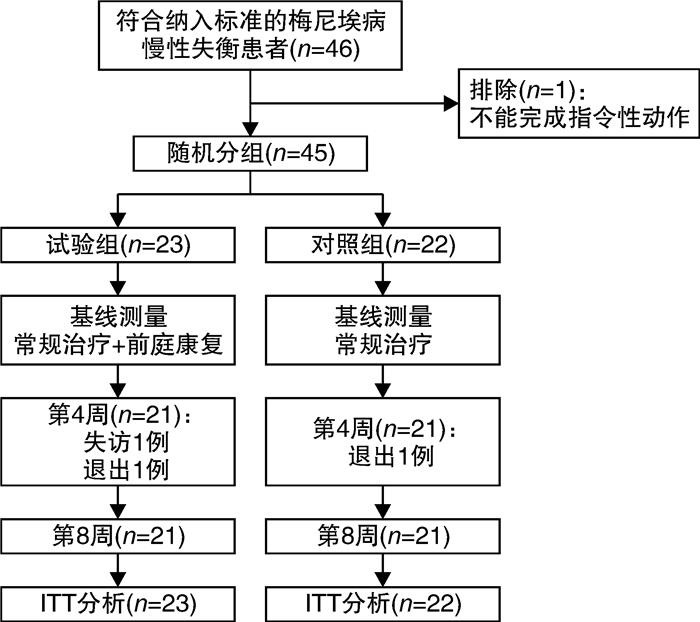The effectiveness of vestibular rehabilitation in Ménière's disease patients with chronic imbalance
-
摘要: 目的 观察前庭康复在梅尼埃病慢性失衡患者中的疗效。方法 入组2020年12月—2021年12月在复旦大学附属眼耳鼻喉科医院眩晕专科门诊就诊的45例梅尼埃病慢性失衡患者,采用随机数表的方法将患者分为试验组(23例)和对照组(22例)。对照组接受门诊常规治疗,试验组在常规治疗的基础上接受为期8周的前庭康复训练。在基线和治疗8周时使用眩晕残障量表(DHI)对所有患者进行评估,计算两组患者的跌倒发生率并记录研究窗口期内的不良事件。结果 两组患者基线资料差异无统计学意义(P>0.05)。研究过程中,有2例患者退出研究,1例患者失访,共42例患者完成试验。对失访患者进行意向性分析。经过8周治疗,两组患者的DHI和DHI-F得分差值的差异有统计学意义(d1=-30.22±3.78,d2=-13.09±4.85,t=-2.799,P < 0.05;d1=-12.43±1.46,d2=-4.55±2.17,t=-3.043,P < 0.05),DHI-P和DHI-E得分差值的差异无统计学意义(P>0.05)。两组患者的跌倒发生率差异无统计学意义(P>0.05),但治疗后试验组的跌倒发生率已较治疗前显著下降(4.35% vs 34.78%,χ2=4.973,P < 0.05)。两组均未报告严重不良事件。结论 前庭康复能够改善梅尼埃病慢性失衡患者的平衡功能,降低患者的跌倒风险,值得临床上推广应用。Abstract: Objective To observe the effectiveness of vestibular rehabilitation in Ménière's disease patients with chronic imbalance.Methods Forty-five Ménière's disease patients with chronic imbalance treated in vertigo specialist clinic of Eye and ENT Hospital of Fudan University from December 2020 to December 2021 were enrolled. Patients were divided randomly into two groups, 23 patients in experimental group and 22 patients in control group. Both groups received routine outpatient treatment, and the experimental group received an additional vestibular rehabilitation for 8 weeks. All patients were evaluated with dizziness handicap inventory (DHI) at baseline and 8-week follow-up, and the incidence of fall was calculated. The occurrence of adverse events during the study was also recorded.Results There was no significant difference in baseline data between the two groups (P>0.05). During the study, 1 patient were lost to follow-up and 2 patients dropped out. A total of 42 patients completed the study. Intentionality analysis was performed on lost follow-up patients. After 8 weeks of the treatment, there were significant statistically differences in difference values of DHI and DHI-F scores(d1=-30.22±3.78, d2=-13.09±4.85, t=-2.799, P < 0.05; d1=-12.43±1.46, d2=-4.55±2.17, t=-3.043, P < 0.05), while no significant difference was showed in the difference values of DHI-P and DHI-E scores(P>0.05). There was no significant difference in incidence of fall between two groups(P>0.05), but the incidence of experimental group decreased significantly compared with that before treatment(4.35% vs 34.78%, χ2=4.973, P < 0.05). No serious adverse event was reported in the two groups.Conclusion Vestibular rehabilitation can improve the balance function and reduce risk of fall in Ménière's disease patients with chronic imbalance. Therefore, it is worthy of clinical application.
-
Key words:
- vestibular rehabilitation /
- Ménière's disease /
- imbalance /
- vertigo
-

-
表 1 两组患者的人口学特征比较
项目 试验组 对照组 统计量 P值 年龄/岁 57.04±2.23 59.73±2.54 Z=-1.091 0.275 性别 χ2=0.538 0.554 男 14(60.87) 11(50.00) 女 9(39.13) 11(50.00) 病程/月 80.74±21.39 54.68±11.86 Z=-0.924 0.355 病侧 χ2=0.044 0.833 左侧 15(65.22) 15(68.18) 右侧 8(34.78) 7(31.82) 合并疾病 χ2=1.138 0.286 有 11(47.83) 14(63.64) 无 12(52.17) 8(36.36) 表 2 治疗前后DHI评分比较
X±S 试验组(n=23) 对照组(n=22) 统计量 P值 DHI 基线 45.57±3.11 45.64±1.98 t=-0.019 0.985 8周 15.35±2.82 35.22±4.82 Z=-2.676 0.007 差值 -30.22±3.78 -13.09±4.85 t=-2.799 0.008 DHI-P 基线 15.35±1.08 18.09±1.11 t=-1.769 0.084 8周 3.91±0.95 10.00±1.65 Z=-2.751 0.006 差值 -11.43±1.42 -8.09±2.13 t=-1.319 0.194 DHI-E 基线 11.04±1.89 9.09±1.20 Z=-0.275 0.783 8周 5.83±1.26 9.00±1.73 Z=-1.460 0.144 差值 -5.22±2.10 -0.09±1.55 t=-1.954 0.057 DHI-F 基线 18.43±1.34 18.27±1.17 t=0.091 0.928 8周 6.00±1.03 13.73±1.83 Z=-3.047 0.002 差值 -12.43±1.46 -4.55±2.17 t=-3.043 0.004 -
[1] Basura GJ, Adams ME, Monfared A, et al. Clinical Practice Guideline: Ménière's Disease[J]. Otolaryngol Head Neck Surg, 2020, 162(2_suppl): S1-S55. doi: 10.1177/0194599820909438
[2] Söderman AC, Bagger-Sjöbäck D, Bergenius J, et al. Factors influencing quality of life in patients with Ménière's disease, identified by a multidimensional approach[J]. Otol Neurotol, 2002, 23(6): 941-948. doi: 10.1097/00129492-200211000-00022
[3] Tyrrell JS, Whinney DJ, Ukoumunne OC, et al. Prevalence, associated factors, and comorbid conditions for Ménière's disease[J]. Ear Hear, 2014, 35(4): e162-169. doi: 10.1097/AUD.0000000000000041
[4] 陈元星, 孙悍军, 张清华, 等. 梅尼埃病与前庭性偏头痛共病患者的临床特点[J]. 临床耳鼻咽喉头颈外科杂志, 2020, 34(9): 820-823. https://www.cnki.com.cn/Article/CJFDTOTAL-LCEH202009012.htm
[5] 彭璐, 尹时华. 前庭康复在前庭疾病的应用进展[J]. 中华耳科学杂志, 2022, 20(3): 493-497. doi: 10.3969/j.issn.1672-2922.2022.03.023
[6] Hall CD, Herdman SJ, Whitney SL, et al. Vestibular Rehabilitation for Peripheral Vestibular Hypofunction: An Evidence-Based Clinical Practice Guideline: FROM THE AMERICAN PHYSICAL THERAPY ASSOCIATION NEUROLOGY SECTION[J]. J Neurol Phys Ther, 2016, 40(2): 124-155. doi: 10.1097/NPT.0000000000000120
[7] 于慧前, 李华伟, 李庆忠. 2020版梅尼埃病临床实践指南解读[J]. 临床耳鼻咽喉头颈外科杂志, 2021, 35(5): 385-390. https://www.cnki.com.cn/Article/CJFDTOTAL-LCEH202105001.htm
[8] 国家卫生健康委员会能力建设和继续教育中心耳鼻喉科专家委员会, 中国中西医结合学会耳鼻咽喉科专业委员会, 中国医疗保健国际交流促进会眩晕医学分会, 等. 前庭康复专家共识[J]. 中华医学杂志, 2021, 101(26): 2037-2043. doi: 10.3760/cma.j.cn112137-20210318-00685
[9] Sulway S, Whitney SL. Advances in Vestibular Rehabilitation[J]. Adv Otorhinolaryngol, 2019, 82: 164-169.
[10] Wu P, Wan Y, Zhuang Y, et al. WeChat-based vestibular rehabilitation for patients with chronic vestibular syndrome: protocol for a randomised controlled trial[J]. BMJ Open, 2021, 11(3): e042637. doi: 10.1136/bmjopen-2020-042637
[11] Zamyslowska-Szmytke E, Politanski P, Jozefowicz-Korczynska M. Dizziness Handicap Inventory in Clinical Evaluation of Dizzy Patients[J]. Int J Environ Res Public Health, 2021, 18(5). 2210-2221. doi: 10.3390/ijerph18052210
[12] Poon DM, Chow LC, Au DK, et al. Translation of the dizziness handicap inventory into Chinese, validation of it, and evaluation of the quality of life of patients with chronic dizziness[J]. Ann Otol Rhinol Laryngol, 2004, 113(12): 1006-1011. doi: 10.1177/000348940411301212
[13] 丁雷, 刘畅, 王嘉玺, 等. 眩晕残障程度评定量表(中文版)的评价[J]. 中华耳科学杂志, 2013, 11(2): 228-230. doi: 10.3969/j.issn.1672-2922.2013.02.014
[14] 张祎, 刘博, 王拥军, 等. 头晕评价量表中文版信度和效度分析[J]. 中华耳鼻咽喉头颈外科杂志, 2015, 50(9): 738-743. doi: 10.3760/cma.j.issn.1673-0860.2015.09.008
[15] 高云, 单希征. 梅尼埃病的病因及发病机制研究进展[J]. 听力学及言语疾病杂志, 2014, 22(4): 426-431. doi: 10.3969/j.issn.1006-7299.2014.04.024
[16] Chow MR, Ayiotis AI, Schoo DP, et al. Posture, Gait, Quality of Life, and Hearing with a Vestibular Implant[J]. N Engl J Med, 2021, 384(6): 521-532. doi: 10.1056/NEJMoa2020457
[17] 崔庆佳, 王蕊, 闫瑾, 等. 前庭外周性眩晕患者前庭康复短期疗效及其影响因素[J]. 临床耳鼻咽喉头颈外科杂志, 2022, 36(3): 217-221. https://www.cnki.com.cn/Article/CJFDTOTAL-LCEH202203013.htm
[18] Lacour M, Bernard-Demanze L. Interaction between Vestibular Compensation Mechanisms and Vestibular Rehabilitation Therapy: 10 Recommendations for Optimal Functional Recovery[J]. Front Neurol, 2014, 5: 285-298.
[19] Nagaratnam N, Ip J, Bou-Haidar P. The vestibular dysfunction and anxiety disorder interface: a descriptive study with special reference to the elderly[J]. Arch Gerontol Geriatr, 2005, 40(3): 253-264. doi: 10.1016/j.archger.2004.09.006
[20] Liu JL, Liu JG, Chen XB, et al. The benefits of betahistine or vestibular rehabilitation(Tetrax biofeedback)on the quality of life and fall risk in patients with Ménière's disease[J]. J Laryngol Otol, 2020, 134(12): 1073-1076. doi: 10.1017/S0022215120002509
[21] Pyykkö I, Pyykkö N, Manchaiah V. Vestibular drop attacks in Ménière's disease[J]. J Vestib Res, 2021, 31(5): 389-399. doi: 10.3233/VES-201502
[22] van Esch BF, van der Scheer-Horst ES, van der Zaag-Loonen HJ, et al. The Effect of Vestibular Rehabilitation in Patients with Ménière's Disease[J]. Otolaryngol Head Neck Surg, 2017, 156(3): 426-434.
-





 下载:
下载: